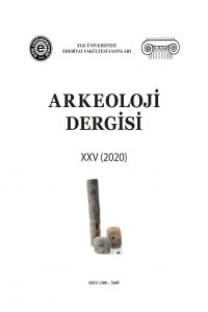GEÇ TUNÇ ÇAĞI TROYA SAVUNMA HENDEĞİARAŞTIRMALARINA JEOARKEOLOJİKKATKILAR
[GEOARCHAEOLOGICAL CONTRIBUTION TO RESEARCH ON THE LATE BRONZE AGE DEFENSIVE DITCH OF TROIA]
___
- Becker 1993: H. Becker, J. Fassbinder, H.G. Jansen, “Magnetische Prospektion in der Untersiedlung von Troya 1992”, Studia Troica, Band 3, 117-134.
- Becker ve Jansen 1994: H. Becker, H.G. Jansen, “Magnetische Prospektion 1993 der Unterstadt von Troya und Ilion”, Studia Troica, Band 4, 105-115.
- Blındow vd. 2000: N. Blindow, H.G. Jansen, K. Schröer, “Geophysikalische Prospektion 1988/99 in der Unterstadt von Troya”, Studia Troica, Band 10, 123-133.
- Hübner ve Giese 2006: C. Hübner, S. Giese, “Geophysikalische Prospektion 2002 bis 2005 in der Unterstadt von Troia”, Studia Troica, Band 16, 125-129.
- Jablonka vd. 1994: P. Jablonka, H. König, S. Riehl, “Ein Verteidigungsgraben in der Unterstadt von Troya VI. Grabungsbericht 1993”, Studia Troica, Band 4, 51-73.
- Jablonka 1995: P. Jablonka, “Ausgrabungen südlich der Unterstadt von Troya im Bereich des Troya VI-Verteidigungsgrabens. Grabungsbericht 1994”, Studia Troica, Band 5, 39-79.
- Jablonka 1996: P. Jablonka, “Ausgrabungen im Süden der Unterstadt von Troya. Grabungsbericht 1995”, Studia Troica, Band 6, 65-96.
- Jablonka ve Pernicka 2007: P. Jablonka, E. Pernicka, “Vorbericht zu den Arbeiten in Troya 2006 (Preliminary report on work at Troya 2006)”, Studia Troica, Band 17, 3-24.
- Jablonka ve Pernicka 2009: P. Jablonka, E. Pernicka, “Vorbericht zu den Arbeiten in Troya 2007 und 2008 (Preliminary report on work at Troya 2007 and 2008)”, Studia Troica, Band 18, 3-32.
- Jablonka vd. 2011: P. Jablonka, E. Pernicka, R. Aslan, “Vorbericht zu den Arbeiten in Troya 2009 und 2010 (Preliminary Report on Work in Troya 2009 and 2010)”, Studia Troica, Band 19, 7-42.
- Jansen vd. 1998: H.G. Jansen, T.L. Kienlin, A.E. Patzelt, M. Waldhör, J. Wilhelm, “Geophysikalische Prospektion 1996/97 in der Unterstadt von Troya”, Studia Troica, Band 8, 275-284.
- Jansen ve Blindow 2003: H.G. Jansen, N. Blindow, “The geophysical mapping of the Lower City of Troya/Ilion”, In: Wagner G.A., Pernicka E., Uerpmann H-P. (Eds.), Troya and Troad. Scientific Approaches. Natural Science in Archaeology, 325-340.
- Jansen 2006: H.G. Jansen, “Das unsichtbare Troya sichtbar gemacht - Chancen und Ergebnisse der Anwendung neuer Prospektionsmethoden”, In: Korfmann M.(Ed.) Troya. Archaologie eines Siedlungshügels und seiner Landschaf, Philipp von Zabern, 309-316.
- Kayan 1995: İ. Kayan, “The Troia bay and supposed harbour sites in the Bronze Age”, Studia Troica, Band 5, 211-235, Philipp von Zabern, Mainz am Rhein, Germany.
- Kayan 1996: İ. Kayan, “Holocene stratigraphy of the Lower Karamenderes-Dümrek plain and archaeological material in the alluvial sediments to the north of the Troia ridge”, Studia Troica, Band 6, 239-249, Philipp von Zabern, Mainz am Rhein, Germany.
- Kayan 1997: İ. Kayan, “Geomorphological evolution of the Çıplak valley and archaeological material in the alluvial sediments to the south of the Lower City of Troia”, Studia Troica, Band 7, 489-507, Philipp von Zabern, Mainz am Rhein, Germany.
- Kayan 2014: İ. Kayan, “Geoarchaeological research at Troia and its environs”, Studia Troica, Monographien 5, (Troia 1987-2012: Grabungen und Forschungen I. Forschungsgeschichte, Methoden und Landschaft. Teil 2 (Herausgegeben von E.Pernicka, C.B.Rose, P.Jablonka), 694-727, Eberhard Karls Universitat Tübingen, Verlag. Dr. Rudolf Habelt GMBH. Bonn, Germany.
- Kayan 2019: İ. Kayan, “Landscape development and changing environment of Troia (North-western Anatolia)”, In: C. Kuzucuoğlu, A. Çiner, N. Kazancı (Eds.), Landscapes and Landforms of Turkey, 277-291.
- Korfmann 1993: M. Korfmann, “Troya-Ausgrabungen 1992”, Studia Troica, Band 3, 1-39.
- Korfmann 1996: M. Korfmann, “Troya-Ausgrabungen 1995”, Studia Troica, Band 6, 1-64.
- Korfmann 2001: M. Korfmann “Troya/Wilusa - Ausgrabungen 2000 (Troya/Wilusa - 2000 Excavations)”, Studia Troica, Band 11, 1-50.
- ISSN: 1300-5685
- Yayın Aralığı: Yılda 2 Sayı
- Başlangıç: 1991
- Yayıncı: Ege Yayınları
Batı Karadeniz'de Heraclea Pontica Yakınlarında Yeni Bir Prehistorik Yerleşim: İnönü Mağarası
Hamza EKMEN, Gülden EKMEN, Ali GÜNEY, Benjamin ARBUCKLE, Gökhan MUSTAFAOĞLU, Cemal TUNOĞLU, Caner DİKER, Ercan OKTAN
Geç Tunç Çağı Troya Savunma Hendeği Araştırmalarına Jeoarkeolojik Katkılar
İlhan KAYAN, Mehmet DOĞAN, Rifat İLHAN, Aylin KARADAŞ, Doğukan Doğu YAVAŞLI, Rüstem ASLAN
Kalkolitik Gülpınar Çanak Çömlekleri Üzerindeki Teknolojik İzler
Abdulkadir ÖZDEMİR, Ayşe ÖZDEMİR
Doğu Anadolu Bölgesi'nin Geç Demir Çağı (Pers/Akhamenid Dönemi) Üzerine Bir Değerlendirme
Murat TOSUN, Umut PARLITI, Eyüp CANER
Tunç Çağı Kılıç Topuzları: Maydos Kilisetepe’den İkiMiken Örneği
Meral BAŞARAN MUTLU, Abdulvahap Onur BAMYACI
Tunç Çağı Kılıç Topuzları: Maydos Kilisetepe'den İki Miken Örneği
A. Onur BAMYACI, Meral BAŞARAN MUTLU
Patara’dan Bir Grup Oinophoros: İkonografi ve ÜretimÜzerine Gözlemler
GEÇ TUNÇ ÇAĞI TROYA SAVUNMA HENDEĞİARAŞTIRMALARINA JEOARKEOLOJİKKATKILAR
Mehmet DOĞAN, İlhan KAYAN, Aylin KARADAŞ, Rifat İLHAN, Doğukan Doğu YAVAŞLI, Rüstem ARSLAN
